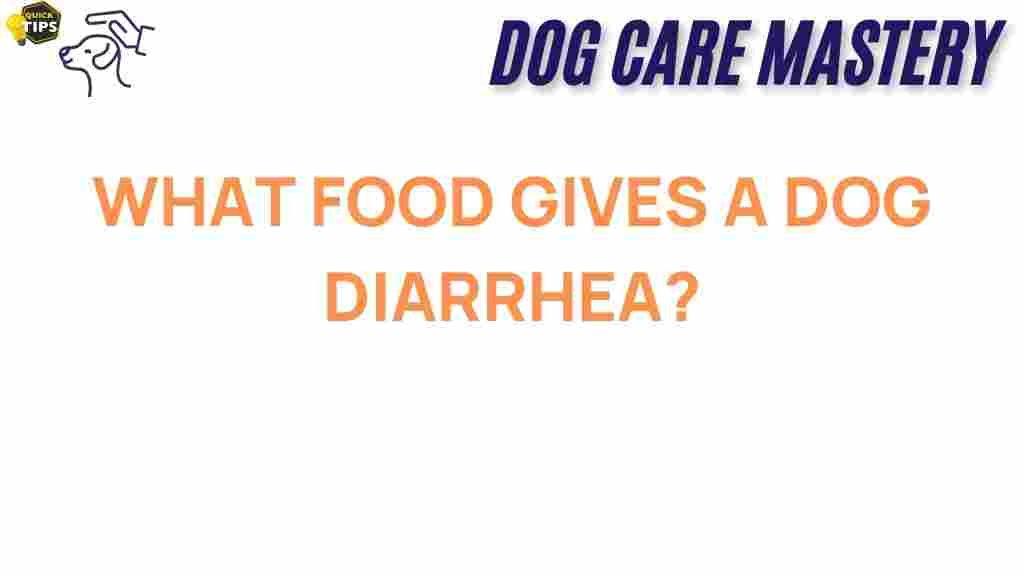Understanding What Food Gives a Dog Diarrhea: A Guide for Pet Owners
As a pet owner, one of the most distressing situations you can encounter is when your beloved dog experiences diarrhea. Dog diarrhea can be caused by a variety of factors, but one of the most common culprits is the food that they consume. Understanding what food gives a dog diarrhea is essential for maintaining your furry friend’s health and well-being.
What Is Dog Diarrhea?
Dog diarrhea is characterized by loose, watery stools that occur more frequently than normal. This condition can lead to dehydration and other health issues if not addressed promptly. It’s vital to recognize the signs of diarrhea and understand its potential causes, especially when it comes to diet.
Common Causes of Dog Diarrhea
Before delving into specific foods that may cause diarrhea in dogs, it’s crucial to understand the broader causes. Here are some common reasons:
- Dietary indiscretion (eating something they shouldn’t)
- Food intolerances or allergies
- Bacterial infections
- Parasites
- Sudden diet changes
- Medications
- Stress and anxiety
Identifying Foods That Cause Dog Diarrhea
Now that we’ve established the common causes, let’s explore specific foods that are known to contribute to dog diarrhea.
1. Dairy Products
Many dogs are lactose intolerant, meaning they have difficulty digesting lactose found in milk and dairy products. Consuming these can lead to gastrointestinal upset and diarrhea.
2. Fatty Foods
High-fat foods can be challenging for dogs to digest, leading to diarrhea. This includes greasy scraps from your table or rich foods intended for humans.
3. Human Foods
Certain human foods are toxic to dogs and can cause diarrhea. These include:
4. Grains
Some dogs may have trouble digesting grains such as wheat, corn, or soy. If your dog is grain-sensitive, consuming these can lead to diarrhea.
5. Raw or Spoiled Food
Feeding your dog raw or spoiled food can introduce harmful bacteria and lead to gastrointestinal distress, resulting in diarrhea.
How to Identify If Food Causes Dog Diarrhea
If you suspect that your dog’s diarrhea is food-related, follow these steps to identify the problem:
1. Keep a Food Diary
Document what your dog eats daily, including treats and any human food. This will help you notice patterns and identify potential triggers.
2. Monitor Symptoms
Along with diarrhea, take note of any other symptoms your dog may exhibit, such as vomiting, lethargy, or changes in appetite.
3. Elimination Diet
Consult your veterinarian about conducting an elimination diet. This involves removing certain foods from your dog’s diet for a period of time and then slowly reintroducing them one at a time to pinpoint the cause of the diarrhea.
Step-by-Step Process for Managing Dog Diarrhea
If your dog is experiencing diarrhea, follow these steps for management:
Step 1: Assess the Severity
Determine if the diarrhea is mild or severe. If your dog shows additional symptoms like vomiting, lethargy, or blood in the stool, contact your veterinarian immediately.
Step 2: Fast Your Dog
For mild cases, consider fasting your dog for 12-24 hours. This gives their digestive system a chance to rest. Make sure they have access to fresh water to prevent dehydration.
Step 3: Introduce a Bland Diet
After the fasting period, introduce a bland diet consisting of:
- Boiled chicken (no skin or bones)
- White rice
- Plain pumpkin (not the spiced pie filling)
Gradually reintroduce their regular food after a few days if symptoms improve.
Step 4: Monitor Progress
Keep an eye on your dog’s stools. If diarrhea persists for more than 48 hours, or if your dog’s condition worsens, seek veterinary care.
Troubleshooting Tips for Preventing Dog Diarrhea
Prevention is always better than cure. Here are some tips to prevent dog diarrhea:
- Gradual Food Changes: Always introduce new foods gradually over several days to avoid digestive upset.
- Quality Food: Feed your dog high-quality, balanced dog food that meets their dietary needs.
- Avoid Table Scraps: Resist the temptation to give your dog human food, especially fatty or seasoned items.
- Regular Vet Check-ups: Regular veterinary visits can help catch potential health issues before they escalate.
When to Seek Veterinary Help
While many cases of dog diarrhea can be managed at home, there are times when you should seek veterinary assistance:
- If diarrhea lasts more than 48 hours
- If there is blood in the stool or vomit
- If your dog shows signs of dehydration (dry gums, excessive thirst)
- If your dog is lethargic or unresponsive
- If your dog is very young, elderly, or has pre-existing health conditions
Conclusion
Understanding what food gives a dog diarrhea is a crucial aspect of responsible pet ownership. By being mindful of your dog’s diet and recognizing the signs of gastrointestinal distress, you can help ensure their overall health and well-being. Always remember that if diarrhea persists or if your dog exhibits more severe symptoms, seeking veterinary advice is the best course of action. For more information on dog health, you can visit this resource, which provides valuable insights for pet owners.
By taking proactive steps and understanding your dog’s dietary needs, you can minimize the risk of dog diarrhea and keep your furry friend happy and healthy.
This article is in the category Nutrition and created by dogcaremastery Team
